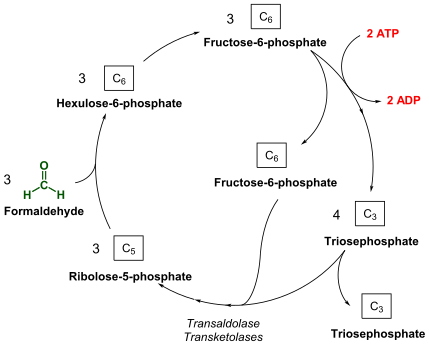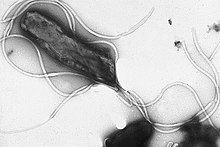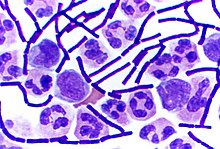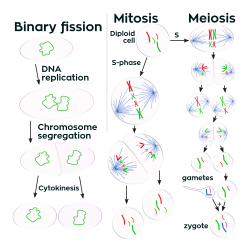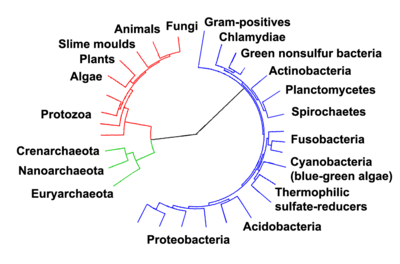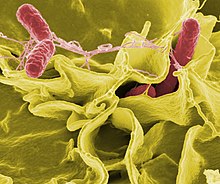Methods and techniques
As of 2014, there are over 30,000 sequenced bacterial genomes publicly available and thousands of metagenome projects. Projects such as the Genomic Encyclopedia of Bacteria and Archaea (GEBA) intend to add more genomes.
The single gene comparison is now being supplanted by more
general methods. These methods have resulted in novel perspectives on
genetic relationships that previously have only been estimated.
A significant achievement in the second decade of bacterial genome sequencing
was the production of metagenomic data, which covers all DNA present in
a sample. Previously, there were only two metagenomic projects
published.
Bacterial genomes
Log-log plot of the total number of annotated proteins in genomes submitted to GenBank as a function of genome size. Based on data from NCBI genome reports.
Bacteria possess a compact genome architecture distinct from eukaryotes
in two important ways: bacteria show a strong correlation between
genome size and number of functional genes in a genome, and those genes
are structured into operons.
The main reason for the relative density of bacterial genomes compared
to eukaryotic genomes (especially multicellular eukaryotes) is the
presence of noncoding DNA in the form of intergenic regions and introns. Some notable exceptions include recently formed pathogenic bacteria. This was initially described in a study by Cole et al. in which Mycobacterium leprae was discovered to have a significantly higher percentage of pseudogenes to functional genes (~40%) than its free-living ancestors.
Furthermore, amongst species of bacteria, there is relatively
little variation in genome size when compared with the genome sizes of
other major groups of life.
Genome size is of little relevance when considering the number of
functional genes in eukaryotic species. In bacteria, however, the strong
correlation between the number of genes and the genome size makes the
size of bacterial genomes an interesting topic for research and
discussion.
The general trends of bacterial evolution indicate that bacteria
started as free-living organisms. Evolutionary paths led some bacteria
to become pathogens and symbionts.
The lifestyles of bacteria play an integral role in their respective
genome sizes. Free-living bacteria have the largest genomes out of the
three types of bacteria; however, they have fewer pseudogenes than
bacteria that have recently acquired pathogenicity.
Facultative
and recently evolved pathogenic bacteria exhibit a smaller genome size
than free-living bacteria, yet they have more pseudogenes than any other
form of bacteria.
Obligate bacterial symbionts or pathogens have the smallest genomes and the fewest pseudogenes of the three groups. The relationship between life-styles of bacteria and genome size
raises questions as to the mechanisms of bacterial genome evolution.
Researchers have developed several theories to explain the patterns of
genome size evolution amongst bacteria.
Genome comparisons and phylogeny
As
single-gene comparisons have largely given way to genome comparisons,
phylogeny of bacterial genomes have improved in accuracy. The Average
Nucleotide Identity method quantifies genetic distance between entire
genomes by taking advantage of regions of about 10,000 bp. With enough
data from genomes of one genus, algorithms are executed to categorize
species. This has been done for the Pseudomonas avellanae species in 2013.
To extract information about bacterial genomes, core- and
pan-genome sizes have been assessed for several strains of bacteria. In
2012, the number of core gene families was about 3000. However, by 2015,
with an over tenfold increased in available genomes, the pan-genome has
increased as well. There is roughly a positive correlation between the
number of genomes added and the growth of the pan-genome. On the other
hand, the core genome has remain static since 2012. Currently, the E. coli
pan-genome is composed of about 90,000 gene families. About one-third
of these exist only in a single genome. Many of these, however, are
merely gene fragments and the result of calling errors. Still, there are
probably over 60,000 unique gene families in E. coli.
Theories of bacterial genome evolution
Bacteria
lose a large amount of genes as they transition from free-living or
facultatively parasitic life cycles to permanent host-dependent life.
Towards the lower end of the scale of bacterial genome size are the
mycoplasmas and related bacteria. Early molecular phylogenetic studies
revealed that mycoplasmas represented an evolutionary derived state,
contrary to prior hypotheses. Furthermore, it is now known that
mycoplasmas are just one instance of many of genome shrinkage in
obligately host-associated bacteria. Other examples are Rickettsia, Buchnera aphidicola, and Borrelia burgdorferi.
Small genome size in such species is associated with certain
particularities, such as rapid evolution of polypeptide sequences and
low GC content in the genome. The convergent evolution of these
qualities in unrelated bacteria suggests that an obligate association
with a host promotes genome reduction.
Given that over 80% of almost all of the fully sequenced
bacterial genomes consist of intact ORFs, and that gene length is nearly
constant at ~1 kb per gene, it is inferred that small genomes have few
metabolic capabilities. While free-living bacteria, such as E. coli, Salmonella species, or Bacillus
species, usually have 1500 to 6000 proteins encoded in their DNA,
obligately pathogenic bacteria often have as few as 500 to 1000 such
proteins.
One candidate explanation is that reduced genomes maintain genes that are necessary for vital processes pertaining to cellular growth and replication, in addition to those genes that are required to survive in the bacteria's ecological niche.
However, sequence data contradicts this hypothesis. The set of
universal orthologs amongst eubacteria comprises only 15% of each
genome. Thus, each lineage has taken a different evolutionary path to
reduced size. Because universal cellular processes require over 80
genes, variation in genes imply that the same functions can be achieved
by exploitation of nonhomologous genes.
Host-dependent bacteria are able to secure many compounds required for metabolism from the host's cytoplasm
or tissue. They can, in turn, discard their own biosynthetic pathways
and associated genes. This removal explains many of the specific gene
losses. For example, the Rickettsia species, which relies on
specific energy substrate from its host, has lost many of its native
energy metabolism genes. Similarly, most small genomes have lost their
amino acid biosynthesizing genes, as these are found in the host instead. One exception is the Buchnera,
an obligate maternally transmitted symbiont of aphids. It retains 54
genes for biosynthesis of crucial amino acids, but no longer has
pathways for those amino acids that the host can synthesize. Pathways
for nucleotide biosynthesis are gone from many reduced genomes. Those
anabolic pathways that evolved through niche adaptation remain in
particular genomes.
The hypothesis that unused genes are eventually removed does not
explain why many of the removed genes would indeed remain helpful in
obligate pathogens. For example, many eliminated genes code for products
that are involved in universal cellular processes, including
replication, transcription, and translation. Even genes supporting DNA recombination and repair are deleted from every small genome. In addition, small genomes have fewer tRNAs, utilizing one for several amino acids. So, a single codon
pairs with multiple codons, which likely yields less-than-optimal
translation machinery. It is unknown why obligate intracellular
pathogens would benefit by retaining fewer tRNAs and fewer DNA repair
enzymes.
Another factor to consider is the change in population that
corresponds to an evolution towards an obligately pathogenic life. Such a
shift in lifestyle often results in a reduction in the genetic
population size of a lineage, since there is a finite number of hosts to
occupy. This genetic drift may result in fixation of mutations that
inactivate otherwise beneficial genes, or otherwise may decrease the
efficiency of gene products. Hence, not will only useless genes be lost
(as mutations disrupt them once the bacteria has settled into host
dependency), but also beneficial genes may be lost if genetic drift
enforces ineffective purifying selection.
The number of universally maintained genes is small and
inadequate for independent cellular growth and replication, so that
small genome species must achieve such feats by means of varying genes.
This is done partly through nonorthologous gene displacement. That is,
the role of one gene is replaced by another gene that achieves the same
function. Redundancy within the ancestral, larger genome is eliminated.
The descendant small genome content depends on the content of
chromosomal deletions that occur in the early stages of genome
reduction.
The very small genome of M. genitalium possesses dispensable genes. In a study in which single genes of this organism were inactivated using transposon-mediated mutagenesis, at least 129 of its 484 ORGs were not required for growth. A much smaller genome than that of the M. genitalium is therefore feasible.
Doubling time
One
theory predicts that bacteria have smaller genomes due to a selective
pressure on genome size to ensure faster replication. The theory is
based upon the logical premise that smaller bacterial genomes will take
less time to replicate. Subsequently, smaller genomes will be selected
preferentially due to enhanced fitness. A study done by Mira et al.
indicated little to no correlation between genome size and doubling time.
The data indicates that selection is not a suitable explanation for the
small sizes of bacterial genomes. Still, many researchers believe there
is some selective pressure on bacteria to maintain small genome size.
Deletional bias
Selection is but one process involved in evolution. Two other major processes (mutation and genetic drift)
can account for the genome sizes of various types of bacteria. A study
done by Mira et al. examined the size of insertions and deletions in
bacterial pseudogenes. Results indicated that mutational deletions tend
to be larger than insertions in bacteria in the absence of gene transfer or gene duplication. Insertions caused by horizontal or lateral gene transfer and gene duplication
tend to involve transfer of large amounts of genetic material. Assuming
a lack of these processes, genomes will tend to reduce in size in the
absence of selective constraint. Evidence of a deletional bias is
present in the respective genome sizes of free-living bacteria, facultative and recently derived parasites and obligate parasites and symbionts.
Free-living bacteria tend to have large population-sizes and are
subject to more opportunity for gene transfer. As such, selection can
effectively operate on free-living bacteria to remove deleterious
sequences resulting in a relatively small number of pseudogenes.
Continually, further selective pressure is evident as free-living
bacteria must produce all gene-products independent of a host. Given
that there is sufficient opportunity for gene transfer to occur and
there are selective pressures against even slightly deleterious
deletions, it is intuitive that free-living bacteria should have the
largest bacterial genomes of all bacteria types.
Recently-formed parasites undergo severe bottlenecks and can rely
on host environments to provide gene products. As such, in
recently-formed and facultative parasites, there is an accumulation of
pseudogenes and transposable elements
due to a lack of selective pressure against deletions. The population
bottlenecks reduce gene transfer and as such, deletional bias ensures
the reduction of genome size in parasitic bacteria.
Obligatory parasites and symbionts have the smallest genome sizes
due to prolonged effects of deletional bias. Parasites which have
evolved to occupy specific niches are not exposed to much selective
pressure. As such, genetic drift dominates the evolution of
niche-specific bacteria. Extended exposure to deletional bias ensures
the removal of most superfluous sequences. Symbionts occur in
drastically lower numbers and undergo the most severe bottlenecks of any
bacterial type. There is almost no opportunity for gene transfer for
endosymbiotic bacteria, and thus genome compaction can be extreme. One
of the smallest bacterial genomes ever to be sequenced is that of the endosymbiont Carsonella rudii.
At 160 kbp, the genome of Carsonella is one of the most streamlined examples of a genome examined to date.
Genomic reduction
Molecular phylogenetics
has revealed that every clade of bacteria with genome sizes under 2 Mb
was derived from ancestors with much larger genomes, thus refuting the
hypothesis that bacteria evolved by the successive doubling of
small-genomed ancestors.
Recent studies performed by Nilsson et al. examined the rates of
bacterial genome reduction of obligate bacteria. Bacteria were cultured
introducing frequent bottlenecks and growing cells in serial passage to
reduce gene transfer so as to mimic conditions of endosymbiotic
bacteria. The data predicted that bacteria exhibiting a one-day
generation time lose as many as 1,000 kbp in as few as 50,000 years (a
relatively short evolutionary time period). Furthermore, after deleting
genes essential to the methyl-directed DNA mismatch repair (MMR) system, it was shown that bacterial genome size reduction increased in rate by as much as 50 times.
These results indicate that genome size reduction can occur relatively
rapidly, and loss of certain genes can speed up the process of bacterial
genome compaction.
This is not to suggest that all bacterial genomes are reducing in
size and complexity. While many types of bacteria have reduced in
genome size from an ancestral state, there are still a huge number of
bacteria that maintained or increased genome size over ancestral states.
Free-living bacteria experience huge population sizes, fast generation
times and a relatively high potential for gene transfer. While
deletional bias tends to remove unnecessary sequences, selection can
operate significantly amongst free-living bacteria resulting in
evolution of new genes and processes.
Horizontal gene transfer
Unlike
eukaryotes, which evolve mainly through the modification of existing
genetic information, bacteria have acquired a large percentage of their
genetic diversity by the horizontal transfer of genes. This creates quite dynamic genomes, in which DNA can be introduced into and removed from the chromosome.
Bacteria have more variation in their metabolic properties,
cellular structures, and lifestyles than can be accounted for by point
mutations alone. For example, none of the phenotypic traits that
distinguish E. coli from Salmonella enterica
can be attributed to point mutation. On the contrary, evidence suggests
that horizontal gene transfer has bolstered the diversification and
speciation of many bacteria.
Horizontal gene transfer is often detected via DNA sequence
information. DNA segments obtained by this mechanism often reveal a
narrow phylogenetic distribution between related species. Furthermore,
these regions sometimes display an unexpected level of similarity to
genes from taxa that are assumed to be quite divergent.
Although gene comparisons and phylogenetic studies are helpful in
investigating horizontal gene transfer, the DNA sequences of genes are
even more revelatory of their origin and ancestry within a genome.
Bacterial species differ widely in overall GC content, although the
genes in any one species' genome are roughly identical with respect to
base composition, patterns of codon usage, and frequencies of di- and
trinucleotides. As a result, sequences that are newly acquired through
lateral transfer can be identified via their characteristics, which
remains that of the donor. For example, many of the S. enterica genes that are not present in E. coli
have base compositions that differ from the overall 52% GC content of
the entire chromosome. Within this species, some lineages have more than
a megabase of DNA that is not present in other lineages. The base
compositions of these lineage-specific sequences imply that at least
half of these sequences were captured through lateral transfer.
Furthermore, the regions adjacent to horizontally obtained genes often
have remnants of translocatable elements, transfer origins of plasmids, or known attachment sites of phage integrases.
In some species, a large proportion of laterally transferred genes originate from plasmid-, phage-, or transposon-related sequences.
Although sequence-based methods reveal the prevalence of
horizontal gene transfer in bacteria, the results tend to be
underestimates of the magnitude of this mechanism, since sequences
obtained from donors whose sequence characteristics are similar to those
of the recipient will avoid detection.
Comparisons of completely sequenced genomes confirm that
bacterial chromosomes are amalgams of ancestral and laterally acquired
sequences. The hyperthermophilic Eubacteria Aquifex aeolicus and Thermotoga maritima each has many genes that are similar in protein sequence to homologues in thermophilic Archaea. 24% of Thermotoga's 1,877 ORFs and 16% of Aquifex's 1,512 ORFs show high matches to an Archaeal protein, while mesophiles such as E. coli and B. subtilis have far lesser proportions of genes that are most like Archaeal homologues.
Mechanisms of lateral transfer
The
genesis of new abilities due to horizontal gene transfer has three
requirements. First, there must exist a possible route for the donor DNA
to be accepted by the recipient cell. Additionally, the obtained
sequence must be integrated with the rest of the genome. Finally, these
integrated genes must benefit the recipient bacterial organism. The
first two steps can be achieved via three mechanisms: transformation,
transduction and conjugation.
Transformation involves the uptake of named DNA from the
environment. Through transformation, DNA can be transmitted between
distantly related organisms. Some bacterial species, such as Haemophilus influenzae and Neisseria gonorrhoeae, are continuously competent to accept DNA. Other species, such as Bacillus subtilis and Streptococcus pneumoniae, become competent when they enter a particular phase in their lifecycle.
Transformation in N. gonorrhoeae and H. influenzae
is effective only if particular recognition sequences are found in the
recipient genomes (5'-GCCGTCTGAA-3' and 5'-AAGTGCGGT-3'. respectively).
Although the existence of certain uptake sequences improve
transformation capability between related species, many of the
inherently competent bacterial species, such as B. subtilis and S. pneumoniae, do not display sequence preference.
New genes may be introduced into bacteria by a bacteriophage that
has replicated within a donor through generalized transduction or
specialized transduction. The amount of DNA that can be transmitted in
one event is constrained by the size of the phage capsid
(although the upper limit is about 100 kilobases). While phages are
numerous in the environment, the range of microorganisms that can be
transduced depends on receptor recognition by the bacteriophage.
Transduction does not require both donor and recipient cells to be
present simultaneously in time nor space. Phage-encoded proteins both
mediate the transfer of DNA into the recipient cytoplasm and assist
integration of DNA into the chromosome.
Conjugation involves physical contact between donor and recipient
cells and is able to mediate transfers of genes between domains, such
as between bacteria and yeast. DNA is transmitted from donor to
recipient either by self-transmissible or mobilizable plasmid.
Conjugation may mediate the transfer of chromosomal sequences by
plasmids that integrate into the chromosome.
Despite the multitude of mechanisms mediating gene transfer among
bacteria, the process's success is not guaranteed unless the received
sequence is stably maintained in the recipient. DNA integration can be
sustained through one of many processes. One is persistence as an
episome, another is homologous recombination, and still another is
illegitimate incorporation through lucky double-strand break repair.
Traits introduced through lateral gene transfer
Antimicrobial resistance
genes grant an organism the ability to grow its ecological niche, since
it can now survive in the presence of previously lethal compounds. As
the benefit to a bacterium earned from receiving such genes are time-
and space-independent, those sequences that are highly mobile are
selected for. Plasmids are quite mobilizable between taxa and are the
most frequent way by which bacteria acquire antibiotic resistance genes.
Adoption of a pathogenic lifestyle often yields a fundamental
shift in an organism's ecological niche. The erratic phylogenetic
distribution of pathogenic organisms implies that bacterial virulence is
a consequence of the presence, or obtainment of, genes that are missing
in avirulent forms. Evidence of this includes the discovery of large
'virulence' plasmids in pathogenic Shigella and Yersinia, as well as the ability to bestow pathogenic properties onto E. coli via experimental exposure to genes from other species.
Computer-made form
In April 2019, scientists at ETH Zurich reported the creation of the world's first bacterial genome, named Caulobacter ethensis-2.0, made entirely by a computer, although a related viable form of C. ethensis-2.0 does not yet exist.



